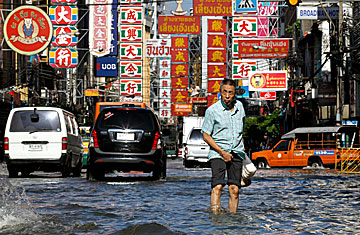
A man wades through a flooded street in Bangkok on Oct. 29, 2011. An estimated 1 million people have fled the Thai capital because of flooding
Hitch a lift with an army truck heading across Pinklao Bridge, which spans the swollen Chao Phraya river near the Grand Palace, and you descend into the grim, half-deserted water world that is now western Bangkok. The runoff from months of catastrophic flooding in central Thailand began inundating outlying districts of the capital last week. The water is inexorably creeping south and, as it combines with this weekend's unusually high tides, threatens to inundate many districts of Bangkok.
The Pinklao area was hit hard. Its once traffic-choked roads are now rivers of stinking chest-high water strewn with garbage. The army truck I ride on is packed with local residents either fleeing the area — most have already left — or taking back supplies. Its passage creates a bow wave that slaps against abandoned storefronts and rolls down canal-like side streets plied by a motley flotilla of rowboats, canoes, inflatable dinghies and makeshift rafts.
One of the truck's passengers is a tour guide called Adisak Boonsarn. "I've never seen anything like it," he says. "It's like a tsunami has come." Today he is heading for his swamped village outside Bangkok to survey what's left of his house and possessions. The 25-km journey will take him five hours — by truck, by boat and by wading through chest-deep water. Adisak abandoned the house two weeks ago, dispatched his wife and children to a dry and distant province, and began sleeping on his office floor in Bangkok with other employees. Now the approaching floods might evict him again. Adisak regards this as a minor inconvenience compared with the suffering in the provinces. "Some people are living on their roofs," he says.
A million people have supposedly fled Bangkok. Many hotels in nearby beach resort towns such as Pattaya and Hua Hin are reportedly full. David Williams, an English teacher from Indiana who has lived in Thailand for 19 years, says that of the 30 houses in his Pinklao neighborhood, only three remain occupied. He lives near Klong Bangkok Noi, a major canal west of the Chao Phraya river. The northern runoff engorged the canal and, by Wednesday, his area was knee-deep in water and most neighbors were evacuating. But Williams, his wife and their daughter moved to the second floor of their four-story home and stayed on. Today the water is waist-deep. "My street is now part of the canal," he says.
Like his neighbors — and like thousands of residents in areas of Bangkok that are yet to flood — Williams built a brick wall to protect his property from the deluge. It proved useless. "The water came through the cracks," he says. "The wall is still standing, but my house is flooded." On Saturday, Williams' neighbors on the opposite bank of Klong Bangkok Noi were fighting a similar battle — this time successfully. The canal water was surging into Taling Chan, a district known to tourists for its floating market. So, with the nearby temple of Wat Kai Tia already shin-deep in putrid water, residents formed a human chain to deliver sandbags that might staunch the torrent.
Their task seemed impossible, but after two backbreaking hours, a dike of concrete-reinforced sandbags reduced the torrent to a trickle. A cheer went up. Women handed out cups of chilled water. One exhausted man flashed the thumbs-up and exclaimed, "Thailand!" The sense of achievement and camaraderie was palpable. Nearby, however, residents were busy erecting brick or sandbag walls outside their homes. It is said the volume of the northern runoff would fill 480,000 Olympic-size swimming pools — as if that helps residents of these imperiled districts better comprehend the threat. In Taling Chan, they already know that the water is arriving in such quantity, and with such force, that human barriers won't necessarily stop it.
Many parts of Bangkok remain unvisited by the floods. I live in Yannawa, a district adjoining both the central business district and one of Bangkok's largest slums. We have had no floods, and recently not even much rain, but most homes and businesses are still fortified by sandbags. A visiting alien might assume we were preparing for urban warfare.
Yannawa hugs a bend in the Chao Phraya river, which could yet break its banks and flood my neighborhood. The northern runoff continues its devastating journey toward the Gulf of Thailand. Last week the waters swamped Don Mueang district, closing Bangkok's second airport and forcing the government's flood-relief nerve center to relocate. "Thon Buri Doomed," declares a headline on the Bangkok Post's website, referring to a historic riverside district that city officials predict could soon be under a meter of water. The flood is also closing in on Siriraj Hospital, on the Chao Phraya's western bank, a highly symbolic landmark: Thailand's revered and ailing King Bhumibol Adulyadej has lived there since 2009.
It is impossible to ignore the resilience and cheer of the people you meet in Bangkok's flood zones. But their smiles quickly fade, and for good reason. David Williams recalled the last time his area was inundated, in 1995, and the month it took for those much lesser floodwaters to recede. "It could take even longer this time," he says. For many Bangkok people, the ordeal is just beginning.
